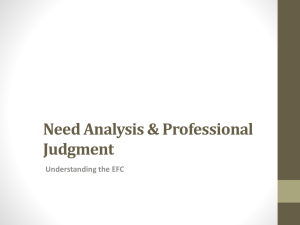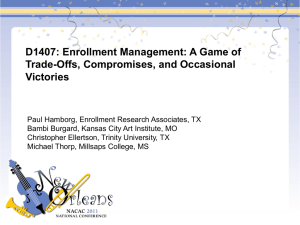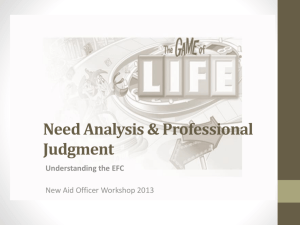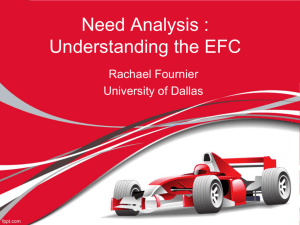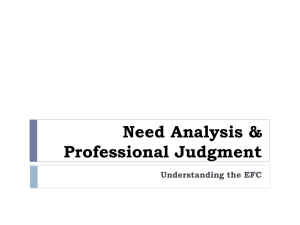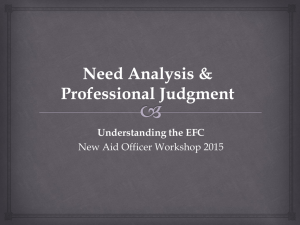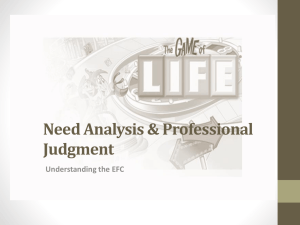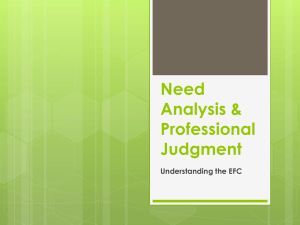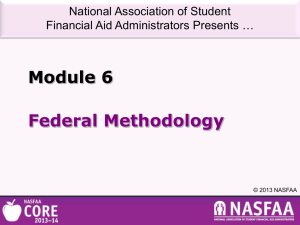Need Analysis & Professional Judgment Understanding
advertisement
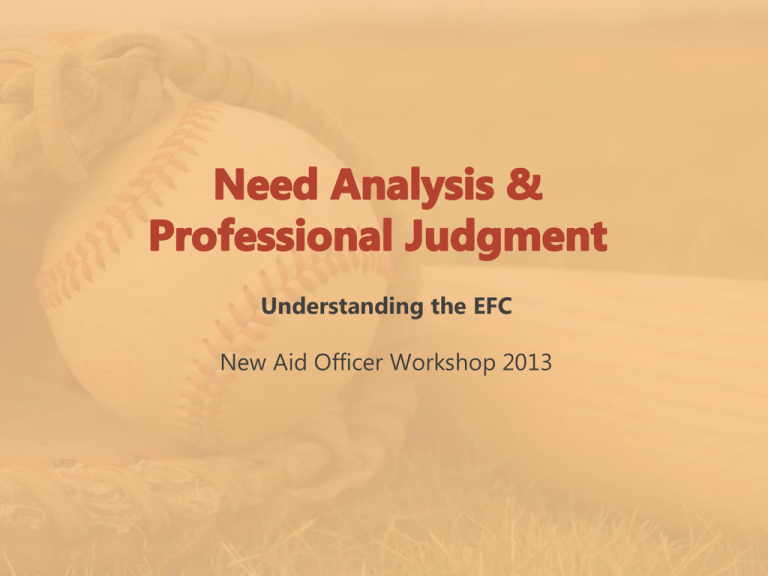
Understanding the EFC New Aid Officer Workshop 2013 Angelika Williams Assistant Director of Financial Aid and Scholarships Texas State University • Definition of Need Analysis • Factors that make up the EFC calculation and why they are important • The various federal formulas • Types of professional judgment decisions and how they are related to the EFC and Need Analysis • What is Professional Judgment • Types of PJ • Definition: The process of determining the student's Expected Family Contribution (EFC) based on the formula established by Congress. Also known as Federal Need Analysis Methodology and Federal Methodology, or FM. • Primary responsibility to pay for education rests with the student and parents/family • Family is expected to contribute to the extent it is able • Families must be evaluated in an equitable manner • Definition: Measure of how much the student and his or her family can be expected to contribute to the cost of the student’s education for the year. • The EFC is calculated according to a formula specified in the law. Basic EFC Formulas • Dependent • Independent w/no dependent(s) • Independent with dependent(s) Factors of EFC Calculations • AGI • Eligible to file a 1040A or EZ • Federal Means Test • Dislocated Worker Total Income • AGI • Wages Earned • Untaxed Income • Additional Financial Information Income Protection: • Taxes Paid • Household Size • Number in college • State and other Tax allowance Protection of Assets • Age of Student (if independent) • Age of Older Parent Cost of Attendance (minus)EFC Need • The EFC determines: – Pell eligibility – Room for need versus non-need-based aid • Formula A – For dependent students • Formula B – For independent students without dependents (other than a spouse) • Formula C – For independent students with dependents other than a spouse For 13-14 EFC worksheets, go to IFAP: http://ifap.ed.gov/fsahandbook/attachments/1314AVGCh3.pdf • There are 3 special EFC Calculations – Regular Formula: Takes BOTH income & assets into account – Simplified Needs Test (SNT):Takes only income into account – Auto-Zero EFC: Student’s EFC is automatically zero • How does a student qualify for SNT? – Must have income (AGI/wages) of $49,999 or less AND – Be eligible to file a 1040A or 1040EZ OR – Qualify for a federal means test benefit program OR – Be a dislocated worker • How does a student qualify for Auto-Zero? – Must have income (AGI/wages) of $24,000 or less AND – Be eligible to file a 1040A or 1040EZ OR – Qualify for a federal means test benefit OR – Be a dislocated worker Only dependent students or independent students with dependents other than a spouse qualify for an auto-zero EFC. • So exactly what is a federal means test benefit program? • • • • • Supplemental Security Income (SSI) Temporary Assistance for Needy Families (TANF) Special Supplemental Nutritional Program for Women, Infants & Children (WIC) Food Stamps/SNAP Free Reduced-Priced School Lunches • • • • • • • Was terminated or laid off from employment or received a notice of termination or layoff; Is unlikely to return to a previous occupation; and Is eligible for or has exhausted unemployment compensation, or is not eligible for compensation because, even though employed long enough to demonstrate attachment to the workforce, he or she had insufficient earnings or performed services for an employer that weren’t covered under a state’s unemployment compensation law; or Was terminated or laid off from employment or received a notice of termination or layoff as a result of any permanent closure of, or any substantial layoff at, a plant, facility, or enterprise; Is employed at a facility at which the employer made a general announcement that it will close; Was self-employed but is now unemployed due to economic conditions or natural disaster; or Is a displaced homemaker • Required to file a long form (1040) if Wages are $100k or more(line 7) Alimony received (line 11) Business or Farm (line 12 & 18) Capital gain or loss (line 13 if schedule D is required) • Rental property (line 17) • Itemized deductions (line 40) • Health Savings account deduction (line 25) • • • • • Eligible to file a 1040A or EZ – If there are capital gains/losses but a Schedule D isn’t required, then a 1040A is fine Which EFC Calculation? • FM automatically protects a set amount of income varied by household size and number in college (called IPA) – Food 30% – Housing 22% – Transportation 9% – Clothing/Personal Care 16% – Medical 11% – Other consumption 12% • US Taxes Paid – Also considers state & other taxes This example is from Worksheet A (dependent students) • Asset Protection: Dept of Ed automatically protects a set amount of assets based on the age of independent students or parents of dependent students – The older the student or parent, the greater the amount of assets protected – due to anticipated retirement This example is from Worksheet A (dependent students) Matching Exercise of EFC Terms • A myriad of elements go into the EFC! – You can’t “guesstimate” what someone’s EFC would be just by asking income information • Having a strong foundation of how the EFC works will help you know if a professional judgment (coming next) will help a student It’s Your Decision! Section 479A in the HEA authorizes us to use PJ • Adjusting Cost of Attendance components • Adjusting data elements used to calculate EFC – Direct changes to EFC is not permitted • Performing a Dependency Override • Establishing eligibility for a dependent student to receive Unsubsidized Stafford if parent refuses to complete FAFSA and support student • • • • • • • • • • • AGI Wages Earned Taxes Paid Number in Household Number in College Additional Financial Information Untaxed Income Asset information Dislocated Worker Status Federal Benefit Programs (i.e.- SNAP, WIC, TANF, etc.) Dependency Status – Only for dependent to independent • DOCUMENT! – Keep in mind that all special circumstances must be verified first to ensure you start with accurate data • Types of documents you may wish to collect – Tax returns – W2s – Last pay stubs – 3rd party documents – Legal documents – Letter from employers – Losses of Income – Unemployment or income reduction – Death of parent/spouse – Divorce of parent/student – Loss of child support – One-time lump sum payout • See GEN-09-04 • Additional Expenses – Extended family support • Such as nursing home expenses – Unusual medical/dental expenses that exceed 11% of the IPA – Unusual nondiscretionary debt that exceeds 12% of the IPA – Private school costs for children in elementary or high school How could some of these factors affect a student’s EFC? • Hands on example: • Let’s say you have a dependent student whose parents experienced an annual medical expense totaling $5,000. The student has 4 in the household and 1 in college. How would you calculate how much of the $5,000 exceeds the 11% of the IPA? Authority given for dependency overrides HEA Section 480(d) • Any student who answers “No” to all the dependency questions is dependent even if student is self-supporting – Students who have extenuating circumstances can request an FAA to consider a dependency override – Requires documentation to the validity of the extenuating circumstances • Personal statement • Letters from professionals • Remember: DOCUMENT, DOCUMENT, DOCUMENT! Per CCRAA, Schools have the authority to accept the dependency override that was performed and approved by another school without additional documentation. • Factors to consider – Abandonment by parents – Unable to locate a parent after reasonable attempts – Situations of abuse None of the following examples merit a dependency override: 1. Parents refuse to contribute to the student's education 2. Parents are unwilling to provide information on the FAFSA or for verification 3. Parents do not claim student as a dependent for income tax purposes 4. Student demonstrates total self-sufficiency • Laura is a first-time freshman living with her grandparents. She is not under legal guardianship, but she has been living with her grandparents since she was 5 when her father left the country. Her mother died when she was 2. She has had no contact with her father since she was 5 and neither has her grandparents, although he sent a check out of the blue when she turned 18 for $5,000. • Would you consider Laura independent? – Why or why not? • FAAs may use professional judgment to determine if a dependent student may be offered unsubsidized Stafford loans without parental data on the FAFSA • To do this, FAAs must verify: – Parent no longer provides financial support – Parent refuses to file the FAFSA – FAA must collect a signed statement from the parent affirming the above while also certifying that they will not provide support in the future (Include the date support ended.) Budgets, budgets, budgets! 1. 2. 3. 4. 5. Tuition & Fees Books & Supplies Room & Board Transportation Personal Expenses • • • • • Additional mortgage/rent charges Unusual car repair or transportation costs Dependent care costs Computer/Laptop expenses Unusual medical/dental expenses not covered by insurance • A PJ is award year specific and cannot carry forward from year to year unless subsequent request & documentation are received • You cannot directly change an EFC • You cannot make changes to the EFC formula • You may not establish automatic categories of special circumstances. All PJ must be conducted on a case by case basis. • PJ cannot be used to circumvent the law • PJ cannot be used to waive student eligibility requirements • PJ cannot make an Independent student dependent Match that PJ! Case Study • Understanding the complexity of the EFC makes you an effective FAA! • You have the authority to use professional judgment so use it (with proper documentation) • 2013-2014 EFC Formula Guide http://ifap.ed.gov/ifap/byAwardYear.jsp?type=efcformulaguide • 2013-2014 FSA Handbook, Application Verification Guide, Chapter 5, Special Cases • DCL: GEN-09-04, GEN-09-05, GEN-11-04, GEN-11-15 • NASFAA 2010: Electronic Handout: Special Populations: Tips for Completing the FAFSA • NASFAA 2009: Q&A from Dependency Status: It’s not the Riddle of the Sphinx Webinar

